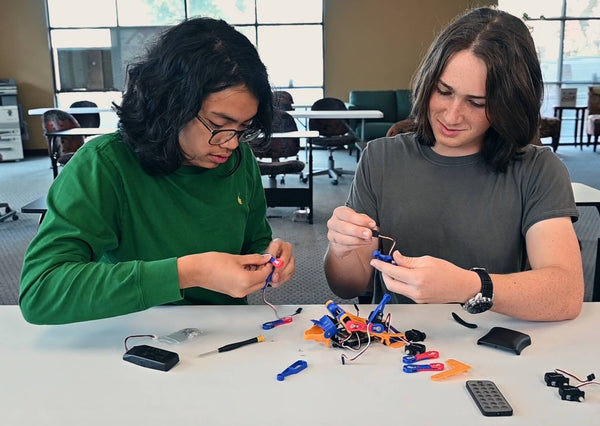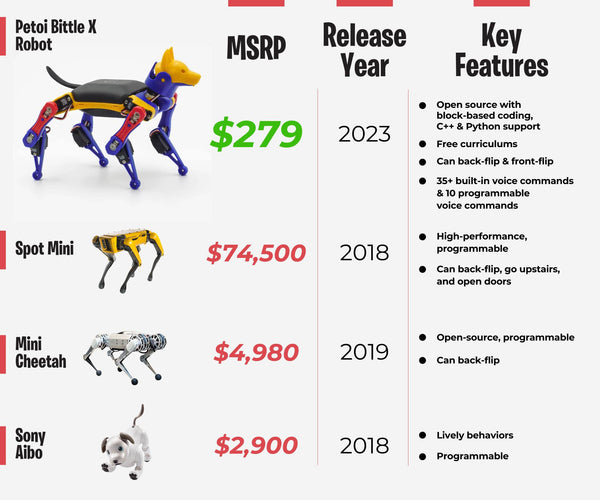Whether it's elementary, middle school, or high school, supporting student journeys with Coding Robot Curriculums or specific robots for classrooms is a fantastic way to lay a practical foundation for students' future STEM education.
In this article, we will go over and compare some of the leading Robotics curriculums. We'll dive deeper into their features, what they offer, who they're for and what you can expect from the robot curriculum:
1. Carnegie Mellon Robotics Academy
Developed by Carnegie Mellons Robotics Academy (CMRA), Carnegie Mellon's easy-to-follow robotics curriculum is comprehensive & can be taught by anyone with a limited understanding or experience in robotics. With ample opportunities to grow from simple into advanced concepts, this is one of the best university robotics programs out there.
What's very interesting about this Robotics Curriculum is that it offers an in-depth programming interface module and a Virtual Robot (as seen in the image above) that is built into the curriculum- this makes Robotics for classroom learning more accessible for everyone.

- Coding and Computational Thinking with Virtual Robot
- Coding and Computational Thinking with SPIKE Prime
What makes CMU's programmable robot curriculum one of the best in the world is its variety of coding languages covered and the diverse options for teachers and educators to try.
For LEGO
- Intro to programming with Virtual EV3
- Introduction to programming with LEGO Mindstorms EV3
When it comes to the coding languages supported and covered, CMU supports, trains and structures its courses around: Scratch, C++, VEX Code C++ & Vex Code Blocks. CMRA also offers online teacher training for all these languages.
Pricing:
While the total cost of your robotics curriculum would come down to the strength of your class and depth of your course, for the sake of understanding, here's a simple unit economics of getting started with CMU's LEGO Mindstorm:- The Robot- One physical LEGO Mindstorm EV3 Robot itself can set you back $300 (if you opt for the virtual one- it can cost less)
- The Course- Live online training for most courses with CMU starts around $599. if you'd like to add Onsite training as well- it should cost you another USD $1099 on top.
Please note these prices are unit {for one only} - assuming you will order a larger quantity of robots for the class- some of the costs will go down with larger order sizes.
Limitations:
Carnegie Mellon University's robotics program is prestigious and one of the best in to the world, however, it does have some limitations, for instance:- The program and curriculum is very diverse and has multiple options to choose from - for educators, this sometimes feels overwhelming and makes it difficult to decide.
- There is no one-stop shop to procure the robots and access the curriculum further adding a little bit of confusion when zeroing in on the best course and curriculum.
2. VEX
The VEX platform boasts of a flexible robot curriculum that effortlessly synchronizes science, design, technology, engineering & programming. VEX curriculums are known to be very comprehensive and are widely used at the junior to high school levels. With a focus on healthy competition through robotics competitions, VEX is at the forefront of collaborative robotics learning. This means that most of their courses encourage teamwork and cooperation between students.
Most loved by teachers all around the world, VEX curriculums are mostly free to download and are available on their website.

Covering every aspect of STEM and all the while engaging students with the fun and excitement of robotics. The programmable robots can be coded with the graphical drag-and-drop or text-based programming, making the programming simple to teach and easy to learn!
Software parts can also be designed and 3d printed while all this is delivered using the free teacher-developed curriculum available online.

For instance:
- VEX 123 (Aimed at pre-K+ with VEX coder cards and simple 123 robots)
- VEX V5 (for grades 9+ with multiple robotic starter kits to choose from)
VEX curriculum are developed for the teachers to integrate smoothly within the classroom. An example of this is VEX STEM Labs (curriculum) which are "plugin lessons" that can fit directly into an existing robotics curriculum.
With a straightforward teacher portal and resources, VEX curriculums are a fantastic option for STEM educators around the world!

(Above is an example of "Over Under"- A project/ game where students learn to build & program STRIKER over a few lessons and learn how to move the robot and score)
Pricing:
Although many of VEX's courses are accessible and affordable (some robot curriculum are even offered for free), the issue with VEX is the price of their robots and hardware.For instance- one VEX EXP Education Classroom robotics kit starts at USD $850.
Limitations:
VEX's robotics curriculum and hardware is expensive due to the expense of components and kits. Additionally, platforms like VEX Robotics are constrained by a fixed set of components and sensors, limiting their suitability for advanced projects or research.
3. FIRST inspires curriculum by LEGO
Developed using a project-based learning method, FIRST curriculum by LEGO is one of the most inclusive curriculums that is competitive, fun, and integrated. Offering courses for Pre-K12 students, grades 2-4 and up to Grades 7-12. the FIRST curriculum has something for everyone. Working with relevant, real-world project scenarios, the curriculum is designed to get students to think beyond just the classroom. Diving into complex real-world technical problems, the robotics curriculum forces out-of-the-box thinking and aligns learning with career exploration and building technical skills that students can take into the 21st-century workforce!
Working with relevant, real-world project scenarios, the curriculum is designed to get students to think beyond just the classroom. Diving into complex real-world technical problems, the robotics curriculum forces out-of-the-box thinking and aligns learning with career exploration and building technical skills that students can take into the 21st-century workforce!Across the LEGO FIRST inspires curriculum, the coding languages in focus are Python text-based programming, Word Block Programming (eg. Scratch) & Unplugged coding.

Above is an example of a completed project from the LEGO FIRST Inspires Robot Curriculum.
Pricing:
Depending on the grade and class strength, the LEGO First Inspires curriculum costs vary. However, irrespective of the robotics curriculum you go for, LEGO Hardware and robots are not cheap.For instance:
1. The LEGO Spark Prime Robot and expansion set (ideal for grades- 4 to 8) will cost you USD $540
2. The REV Robotics education kit (part of the FIRST tech challenge ideal for grades- 7 to 12) will cost you USD $840 as well.
(this is only the cost of the robot/ hardware- registration and curriculum costs like Teacher training and additional Engineering Textbooks are extra)
Limitations:
The LEGO FIRST Inspires robotic curriculum, while fun and engaging, has some limitations.- Costly equipment (along with curriculum costs) may hinder accessibility for some schools or students. The platform's educational focus may lack advanced features found in professional-grade kits, hindering exploration of complex concepts.
- Sometimes, the focus and encouragement of competition can also sideline the focus on pure education and learning.
Despite these constraints, the program remains effective in engaging students with robotics concepts.
4. Petoi Block-Based & C++ Robotics Coding Curriculum for every student to build and code a robot pet

Petoi's robotics curriculums are extensive, easy to follow, and excellent for educators. First off, it's very hard to find a curriculum that involves affordable quadrupeds. Petoi's Bittle Robot Dog & Nybble Robot Cat make learning and teaching a breeze.
Providing an unmatched learning experience, kids and adults recognize cat and dog movement- facilitating curiosity and adding flavor to the learning process.
Whether it's teens or elementary school students, they first learn to build their own robot dogs with robot kits:

Once they see the versatility and real-life-like movements of Petoi's programmable robot dog & cat, the first thing they want to do is learn how to move the robots themselves with the mobile app and coding. Not only does this subtly expose young minds to the physics of four-legged motion, but it also urges students to think deeply about robot motion, balance and real dynamic movements.

Petoi also provides a series of block-based robotics coding video tutorials that cover everything - from the initial setup of the robots to actual movement!
For higher grade students, Petoi offers a free C++ quadruped robotics curriculum that covers from C++ basic to quadruped robotics movement coding.
In addition, Petoi robots come with the free Petoi Skill Composer to help any student easily create robot skills. A free video tutorial series helps anyone get started.
Pricing:
What makes Petoi's robot curriculum a lucrative and accessible option for educators around the world, is minimal financial constriants- whether in hardware or the curriculum itself.
First off, the curriculum is diverse, hands-on and practical, and it is free of cost. Petoi's curriculum is also easily accessible on YouTube and on the website without any costly subscription or complex LMS.
Secondly the cost of the quadruped robots is one of the most affordable in the world. For instance: A Petoi Bittle Robot Dog starts at only USD $269 while A Petoi Nybble Robot cat starts at only USD $299.

Please note: while these affordable prices are for the cost for one robot only, Petoi for Educator Program offers fantastic offers and training support. You can get in touch to find out more.
Petoi has introduced new robotics competition ideas, taking learning a step further from just the classroom walls. This makes Petoi one of the most affordable, flexible, and complete end to end Robotics Curriculums out there!
Want to learn more about Petoi's Block Based Robotics Coding curriculum?
Start now:


